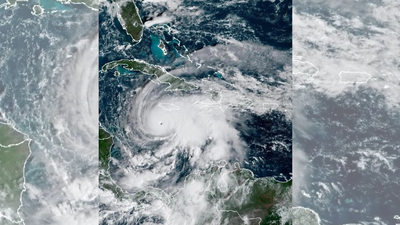ARTICLE AD BOX

Hurricane Melissa moving towards Jamaica (AP)
Hurricane Melissa, now a Category 5 system and the strongest storm anywhere in the world this year, is barreling toward Jamaica with sustained winds nearing 280 km/h, threatening catastrophic flooding, landslides and coastal storm surges across the Caribbean.
The US national hurricane center (NHC) said the storm, which underwent explosive intensification over the weekend, has become a “potentially catastrophic” cyclone as it inches closer to the island’s southern coastline.By late Monday, Melissa was located roughly 200 km south-southwest of Kingston, moving slowly westward at about 5 kilometres per hour - a sluggish pace that forecasters warn will amplify rainfall and prolong destructive winds over Jamaica and neighbouring islands.
The system has already lashed parts of Haiti and the Dominican Republic, leaving several dead and thousands displaced, according to the AP.Meteorologists describe Melissa as the most powerful Atlantic hurricane of the 2025 season, drawing strength from exceptionally warm ocean waters - nearly 2-3 °C above average - and calm upper-level winds that have allowed it to rapidly intensify. Authorities in Jamaica have ordered evacuations along low-lying southern areas, shuttered airports, and urged residents to brace for what Prime Minister Andrew Holness called a “historic and life-threatening event.
”
Track and timing
Melissa is forecast to cross Jamaica late early Tuesday, then advance toward eastern Cuba on Tuesday night and reach the Bahamas by Wednesday.At the latest advisory, the storm was located roughly 205 km south-southwest of Kingston, Jamaica, moving westward at about 6 km/h. The slow pace is a key factor in the threat, it increases the duration of exposure to high winds and heavy rain, and allows flooding and landslides to build.
Strength and intensification
Experts say Melissa’s rapid escalation to Category 5 was driven by unusually warm Atlantic waters and favourable atmospheric conditions. According to the NHC and other meteorologists, the storm may now rank among the most powerful ever to enter the Caribbean Sea, with sustained winds around 175 mph. The NHC issued stark warnings: “Catastrophic and life-threatening flash flooding and numerous landslides are likely today through Tuesday.”
Impacts so far & risks ahead
- In Jamaica, authorities imposed mandatory evacuations for parts of the southern coast including Port Royal and activated emergency funding of at least US $33 million.
- Prior to reaching Jamaica, Melissa triggered heavy rainfall across Haiti and the Dominican Republic, with confirmed deaths and large-scale evacuations.
- Forecasters expect rainfall totals of up to 40 inches (≈1 m) in portions of Jamaica, and storm surge peaking near 13 feet (4 m) along the southern coast.
- Mountainous regions are especially vulnerable: the combination of heavy rain, steep slopes and deforested terrain raises landslide danger
Preparation and warnings
Prime Minister Andrew Holness of Jamaica emphasised: “There is no infrastructure in the region that can withstand a Category 5.” Transport Minister Daryl Vaz urged residents: “Don’t make foolish decisions… We are in a very, very serious time over the next few days.” Shelters have been opened and airports closed. Still, concerns linger about looting, inability to evacuate remote communities and potential delays in aid due to cut-off roads and communication loss.
Climate context
Meteorologists say storms like Melissa are emblematic of a warming world: ocean temperatures in the relevant zone are about 2-3 °C above average, creating a “vast reservoir of energy” for hurricane intensification. “It doesn’t mean every single cyclone will go through rapid or super-rapid intensification,” noted climate scientist Bernadette Woods Placky, “but in our warmer world, it will continue to increase the likelihood of storms going through rapid or super-rapid intensification.”(With inputs from agecies)

 10 hours ago
5
10 hours ago
5









 English (US) ·
English (US) ·